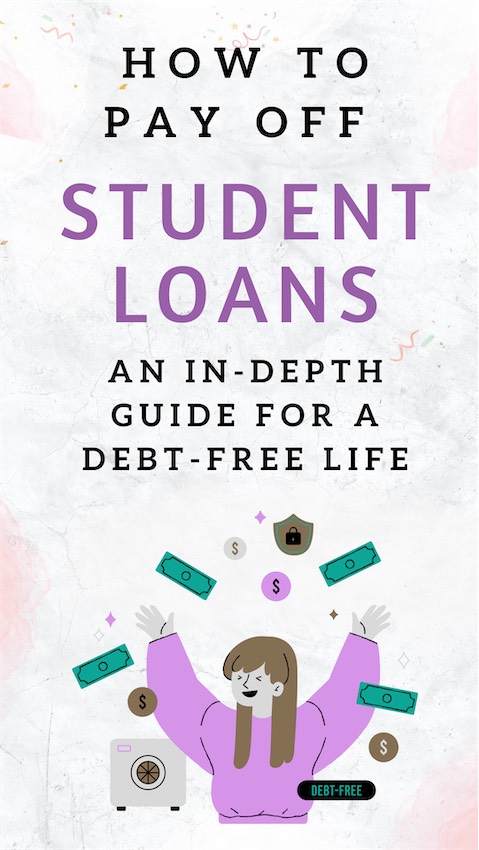Last updated on at 06:01 am
Paying back your student loans can be a daunting task, especially if you have a large amount of debt and a low income. You may feel overwhelmed by the monthly payments, the interest charges, and the long repayment term. You may wonder how you can ever get out of debt and achieve your financial goals. But don’t worry, you are not alone in this situation. Millions of students and new graduates face the same challenge of paying back their student loans. And there are ways to make it easier and faster.
In this post, we will share some tips on how to pay back your student loans without sacrificing your quality of life or your sanity. These tips will help you save money on interest, reduce your debt faster, and improve your credit score. Whether you have federal or private loans, subsidized or unsubsidized loans, or a combination of both, these tips will help you create a plan that works for you and your budget. So let’s get started!
Know What You Are Dealing With
Before you can start paying off your student loans, you need to have a clear picture of your debt situation. This means knowing how much you owe, who your lenders or servicers are, and what kind of repayment plans you have or can choose from. Having this information will help you create a realistic budget and a smart strategy for your debt payoff.

To find out the details of your student loans, you can use different sources depending on the type of loans you have. For federal loans, you can log in to the Federal Student Aid website with your FSA ID and access your loan summary. For private loans, you can contact your lenders directly or check your loan statements. You should also check your credit report regularly to make sure there are no errors or inconsistencies in your loan accounts. You can get a free copy of your credit report once a year from each of the three major credit bureaus: Equifax, Experian, and TransUnion.
Some of the things you should know about your loans are:
- The type of loan (federal or private, subsidized or unsubsidized, etc.). The type of loan you have determines who your lender or servicer is, what interest rate you pay, what repayment options you have, and what benefits or drawbacks you may face. For example, federal loans are loans that are funded by the government and have fixed interest rates, flexible repayment plans, and various forgiveness programs. Private loans are loans that are funded by banks, credit unions, or other lenders and have variable interest rates, stricter repayment terms, and fewer benefits. Subsidized loans are loans that the government pays the interest on while you are in school, during your grace period, or during deferment. Unsubsidized loans are loans that you are responsible for paying the interest on at all times.
- The interest rate and how it is calculated. The interest rate is the percentage of your loan balance that you pay as a cost of borrowing money. The interest rate can be fixed or variable, depending on the type of loan you have. A fixed interest rate means that the rate stays the same throughout the life of the loan. A variable interest rate means that the rate can change over time based on market conditions. The interest rate is calculated by multiplying your loan balance by the annual percentage rate (APR) and dividing by 365 (or 366 in a leap year). This gives you the daily interest amount, which is added to your loan balance every day.
- The loan balance and how much interest has accrued. The loan balance is the amount of money you owe on your loan, including the principal and the interest. The principal is the original amount of money you borrowed, while the interest is the cost of borrowing that money. The loan balance can increase or decrease over time, depending on how much you pay and how much interest accrues. The interest accrues daily based on your loan balance and interest rate. You can find out your current loan balance and accrued interest by logging into your online account or contacting your lender or servicer.
- The monthly payment amount and due date. The monthly payment amount is the amount of money you have to pay each month to repay your loan. The monthly payment amount depends on your loan balance, interest rate, repayment plan, and term. The due date is the date by which you have to make your monthly payment to avoid late fees or penalties. You can find out your monthly payment amount and due date by logging into your online account or contacting your lender or servicer.
- The repayment plan and term. The repayment plan is the arrangement that determines how much you pay each month, how long you have to pay, and how your payment is calculated. The term is the length of time you have to repay your loan in full. There are different repayment plans for federal and private loans, and they vary in terms of monthly payment amount, interest rate, repayment term, and eligibility criteria. You can choose a repayment plan that works for you based on your financial situation and goals. You can also change your repayment plan if your circumstances change.
- The grace period (if any) before payments start. The grace period is a period of time after you graduate, leave school, or drop below half-time enrollment before you have to start making payments on your student loans. The grace period can give you some time to find a job, adjust to your budget, and prepare for repayment. The grace period varies depending on the type of loan you have. For example, most federal loans have a six-month grace period, while most private loans have a shorter or no grace period.
- The servicer or lender that handles your payments. The servicer or lender is the company that manages your student loans and collects your payments. They are also responsible for providing customer service, sending statements and notices, reporting to credit bureaus, and applying for benefits or programs on your behalf. You should know who your servicer or lender is and how to contact them if you have any questions or issues with your student loans.
- The benefits or drawbacks of each loan (such as deferment, forbearance, forgiveness, etc.). Each type of loan may have some benefits or drawbacks that can affect your repayment experience. For example, some federal loans may qualify for deferment, forbearance, forgiveness, or discharge programs that can temporarily or permanently reduce or eliminate your debt under certain conditions. However, these programs may also have eligibility requirements, tax implications, or other consequences that you should be aware of. Some private loans may offer flexible terms, such as interest-only payments, extended terms, or hardship programs that can help you lower your monthly payment or adjust it to your income. However, these options may also increase the total amount of interest you pay or have other drawbacks.
Knowing these details will help you plan your budget, choose the best repayment option, and avoid missing payments or paying unnecessary fees.
Choose a Repayment Plan That Works for You
After you have a clear picture of your student loans, you need to decide how you want to pay them back. This means choosing a repayment plan that fits your financial situation and goals. Different repayment plans have different features and requirements, so you should compare them carefully and pick the one that works best for you.
The repayment plans available for your student loans depend on the type of loans you have. For federal loans, you have several options, such as the standard, graduated, extended, or income-driven repayment plans. These plans differ in how much you pay each month, how long you have to pay, and how your payment is calculated. For private loans, your options may be more limited, depending on your lender. Some lenders may offer flexible terms, such as interest-only payments, extended terms, or hardship programs. Others may have strict terms that require you to pay a fixed amount every month for a set period of time. You should contact your lender to find out what options are available for your loans.
For federal loans, you can choose from the following repayment plans:
- Standard Repayment Plan: This is the default plan that requires you to pay a fixed amount every month for 10 years. This plan will save you the most money on interest, but it may also have the highest monthly payment.
- Graduated Repayment Plan: This plan starts with lower payments that increase every two years for 10 years. This plan may be suitable if you expect your income to grow over time, but it will also cost you more in interest than the standard plan.
- Extended Repayment Plan: This plan allows you to pay a fixed or graduated amount every month for up to 25 years. This plan will lower your monthly payment, but it will also increase the total amount of interest you pay.
- Income-Driven Repayment Plans: These plans base your monthly payment on a percentage of your discretionary income and extend your repayment term to 20 or 25 years. These plans may be ideal if you have a low or unstable income, as they can reduce your payment to as low as $0 per month. However, they will also increase the total amount of interest you pay, and any remaining balance after the repayment term will be forgiven but taxed as income.
Private loans are different from federal loans in many ways, including the repayment options they offer. Depending on your lender, you may have more or less flexibility in how you pay back your private loans. You should contact your lender to find out what options are available for your loans.
Some lenders may offer flexible terms that can help you lower your monthly payment or adjust it to your income. For example, some lenders may allow you to pay only the interest for a certain period of time, extend your repayment term, or apply for a hardship program if you face financial difficulties. However, these options may also increase the total amount of interest you pay or have other drawbacks. Other lenders may have strict terms that require you to pay a fixed amount every month for a set period of time. These terms may help you pay off your debt faster and save money on interest, but they may also be harder to afford or change.
Make Extra Payments Whenever Possible
If you want to pay off your student loans faster and save money on interest, one of the best strategies you can use is to make extra payments whenever possible. Extra payments are any payments that go beyond the minimum amount due each month. By making extra payments, you can reduce your loan balance faster, lower your interest charges, and shorten your repayment term.
You can make extra payments by using any extra income you have, such as bonuses, tax refunds, gifts, or side hustles. You can also make extra payments by cutting down on unnecessary expenses, such as eating out, shopping, or entertainment. You can use online tools like Student Loan Hero or The College Investor to calculate how much you can save by making extra payments. You should also specify that the extra payment should go toward the principal balance of your loan (not the interest or future payments) and target the loan with the highest interest rate first (unless you prefer the debt snowball method).
However, before you make extra payments, you should make sure that:
- You have an emergency fund of at least $1,000 to cover unexpected expenses. An emergency fund is a savings account that you can use for emergencies, such as medical bills, car repairs, or job loss. Having an emergency fund can help you avoid using your credit cards or taking out more loans when you face a financial crisis. It can also give you peace of mind and security. You should aim to save at least $1,000 in your emergency fund, or more if you have a large family or a high-risk job.
- You are current on all your other bills and debts. Before you make extra payments on your student loans, you should make sure that you are paying the minimum amount due on all your other bills and debts, such as rent, utilities, credit cards, car loans, etc. Paying your bills and debts on time can help you avoid late fees, penalties, and damage to your credit score. It can also help you maintain a good relationship with your creditors and service providers. You should prioritize your bills and debts according to their importance and urgency, and pay them as soon as possible.
- You are saving for other important goals, such as retirement or a down payment. While paying off your student loans is a worthy goal, it should not be your only goal. You should also save for other important goals that can improve your financial future, such as retirement or a down payment for a house. Saving for retirement can help you secure your income and lifestyle when you stop working. Saving for a down payment can help you buy a house and build equity. You should allocate a portion of your income to these goals every month, and invest them wisely.
- You specify that the extra payment should go toward the principal balance of your loan (not the interest or future payments). When you make an extra payment on your student loan, you should make sure that it goes toward the principal balance of your loan, not the interest or future payments. The principal balance is the amount of money you borrowed, while the interest is the cost of borrowing that money. By paying down the principal balance, you can reduce the amount of interest that accrues on your loan, and thus lower the total cost of your loan. To specify that the extra payment should go toward the principal balance, you should contact your lender or servicer and follow their instructions.
- You target the loan with the highest interest rate first (unless you prefer the debt snowball method). If you have multiple student loans with different interest rates, you should target the loan with the highest interest rate first when making extra payments. This is because the loan with the highest interest rate costs you the most money over time. By paying off this loan first, you can save more money on interest and free up more money to pay off other loans. This method is called the debt avalanche method. However, if you prefer to pay off the smallest loan first to gain momentum and motivation, you can use the debt snowball method instead. This method may cost you more in interest, but it may also help you stay focused and motivated.
Making extra payments can help you reduce your loan balance faster, lower your interest charges, and shorten your repayment term.
Refinance Your Loans if It Makes Sense
Refinancing your student loans is another option that can help you pay back your debt more easily and quickly. Refinancing means taking out a new loan with a different lender that has better terms and conditions than your current loans. By refinancing, you can consolidate your multiple loans into one loan, simplify your payments, and lower your interest rate and/or repayment term.
This can be a great way to save money and pay off your debt faster, but it is not a good option for everyone. Here are some reasons why refinancing may not be worth it for you:
- You have federal loans and want to keep the benefits they offer. Federal loans come with various benefits that can help you manage your debt, such as income-driven repayment plans, forgiveness programs, deferment, forbearance, etc. These benefits can reduce your monthly payment, extend your repayment term, or even cancel some of your debt in certain situations. However, if you refinance your federal loans with a private lender, you will lose these benefits and have to follow the terms and conditions of the new loan. You should weigh the pros and cons of refinancing carefully and consider how much you value the benefits of your federal loans.
- You have a low credit score or income and can’t qualify for a lower interest rate or better terms. Refinancing your student loans requires you to apply for a new loan with a different lender. The lender will check your credit score, income, debt-to-income ratio, and other factors to determine your eligibility and interest rate. If you have a low credit score or income, or a high debt-to-income ratio, you may not qualify for a lower interest rate or better terms than your current loans. In fact, you may end up paying more in interest or fees if you refinance with a higher interest rate or longer repayment term. You should check your credit score and income before you apply for refinancing and compare the offers from different lenders.
- You have to pay high fees or penalties to refinance your loans. Refinancing your student loans may involve paying some fees or penalties to your current or new lender. For example, some lenders may charge an origination fee, an application fee, a prepayment penalty, or a late payment fee. These fees or penalties can add up to a significant amount and reduce the savings you get from refinancing. You should read the fine print of your current and new loan agreements carefully and find out what fees or penalties are involved in refinancing.
- You extend your repayment term and end up paying more in interest. Refinancing your student loans may lower your monthly payment by extending your repayment term. For example, if you have 10 years left on your current loans and you refinance them with a 20-year term, you will pay less each month but for a longer period of time. However, this also means that you will pay more in interest over the life of the loan. The longer you take to pay off your debt, the more interest you will accrue and the more money you will spend. You should consider how much interest you will save or pay by refinancing and how long you want to be in debt.
Refinancing your student loans can be a smart move if you can get a better deal from a different lender. However, you should not settle for the first offer you get. You should shop around and compare the rates and terms from different lenders to find the best option for you.
To make this process easier and faster, you can use online tools that help you compare offers from multiple lenders in minutes. For example, you can use Credible or NerdWallet to see how much you can save by refinancing your student loans. These tools will show you the interest rate, monthly payment, repayment term, and total cost of each offer. You can also filter the offers by your preferences, such as fixed or variable rate, loan amount, loan term, etc. By using these tools, you can find the best refinancing option for your student loans.
Stay Motivated and Celebrate Your Progress
Paying back your student loans is not only a financial goal, but also a personal achievement. It takes a lot of dedication, discipline, and perseverance to pay off your debt and free yourself from its burden. That’s why you should stay motivated and celebrate your progress along the way. Here are some tips to help you do that:
- Set realistic and specific goals for your debt payoff, such as paying off a certain loan or amount by a certain date. Write down your goals and track your progress regularly. Seeing how far you’ve come and how close you are to your finish line can boost your motivation and confidence.
- Reward yourself for reaching milestones, such as making an extra payment or paying off a loan. Treat yourself to something you enjoy, such as a movie, a meal, or a hobby. You deserve to celebrate your hard work and achievements.
- Join a community of like-minded people who can support you and hold you accountable, such as a Facebook group or a podcast. You can share your stories, challenges, tips, and successes with others who understand what you’re going through. You can also learn from their experiences and get inspired by their progress.
- Visualize how you will feel and what you will do when you are debt-free. Imagine the relief, joy, and pride you will feel when you make your last payment. Think about the things you can do with the money you save, such as traveling, investing, or donating. Having a clear vision of your debt-free future can help you stay focused and motivated.
You may feel overwhelmed by the thought of paying back your student loans, but you don’t have to be. There are many ways to make your debt repayment easier and faster. You can follow these tips to create a plan that works for you, save money on interest, and achieve your financial goals.
Remember, you are not alone in this journey. Millions of students and new graduates are facing the same challenge of paying back their student loans. You can find support and inspiration from others who are in the same situation or who have successfully paid off their debt. You can also use online resources and tools to help you manage and repay your student loans. You have the power and the potential to pay off your debt and free yourself from its burden. You can do this!
Parting Thoughts
Student loans are a common burden for many students and new graduates around the world. However, they don’t have to ruin your life or prevent you from pursuing your dreams. With some planning, discipline, and creativity, you can pay back your student loans and free yourself from debt.
If you need more help or guidance on how to pay back your student loans, you can check out some of the resources below:
- Student Loan Hero: A website that provides tools, calculators, guides, and advice on how to manage and repay student loans.
- The Student Loan Planner: A website that offers student loan consulting services, podcasts, blogs, and courses on how to pay off student loans faster and smarter.
- The College Investor: A website that covers topics such as student loan refinancing, forgiveness, repayment strategies, investing, and more.
I hope this post has been helpful and informative for you. If you have any questions or feedback, please feel free to leave a comment below. Thank you for reading!
📌 Pin to Save 📌

Follow me on:





This is awesome as I just finished paying off my student loans. Great tips! Best feeling once you’re finished.
This is so important for people to know. It is so sad how many are struggling to pay off student loans with nothing left for their families.
This is a really helpful post at a great time as I am thinking of going back for my masters and it’s been awhile since I obtained my bachelors.